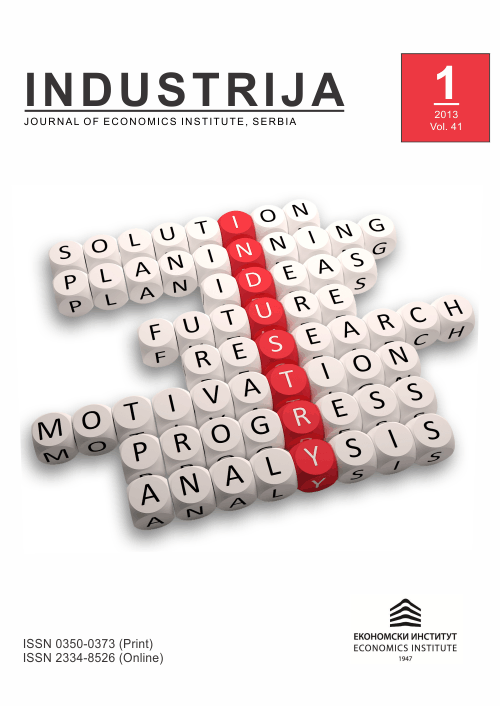Needs, effectiveness and limitations of the industrial policy of Serbia
Abstract
Based on the position and the role of the industry that decisively affects the overall level of economic dynamics (GDP growth, employment rate, exports, competitiveness, innovation) this paper discusses some of the key factors which in an environment of deindustrialization of the Serbian economy call for the development and implementation of industrial policy, which is, again, the essential requirement for reindustrialization of the country. Building on the theoretical and methodological analysis of the most dominant contemporary concepts of industrial policy, the authors point to the need for setting and implementing an active, flexible and sophisticated industrial policy as an integral part of the socio-economic development of the country, since in this way the accumulation of structural disproportions can be achieved, as well as a more balanced presence on the world market. Current state of the industry characterized by a relatively modest share in the GDP generation and overall employment, low productivity and competitiveness levels, outdated technologies, insufficient innovation and R&D is a result of the irresponsible attitude of the state towards this economic sector. Due to the presence of the existing economic, financial and industrial limitations, it is necessary for the state to define a consistent and sustainable industrial policy concept and include all relevant stakeholders - ministries, employers, trade unions, research institutions and consumer organizations, in its implementation
References
--
Atkinson, B., Baker, R., & Milward, B. (1996). Economic policy. London-New York, itd.: Macmillan Publishing.
Cimoli, M., Dosi, G., & Stiglitz, E.J. (2009). The Political Economy of Capabilities Accumulation: The Past and Future of Policies for Industrial Development, Industrial Policy and Development - The Political Economy of Capabilities Accumulation. New York: Oxford University Press.
-European Commission. (2012). European Innovation Scoreboard 2011- Enterprise and Industry. Belgium.
-Ministry of Finance of the Republic of Serbia. (2011). Development report 2010.
Jakopin, E. (2012). Postkrizna realokacija faktora rasta. Ekonomski horizonti, 14(2), 77-87. Retrieved from http://scindeks.ceon.rs/article.aspx?artid=1450-863X1202077J0 doi:10.5937/ekonhor1202077J
Kornai, Я. (2002). Системная парадигма. Вопрoсы экономики, 4, 17-23.
Mićić, V., & Zeremski, A.V. (2011). Deindustrijalizacija i reindustrijalizacija privrede Srbije. Industrija, 39(2), 51-68. Retrieved from http://scindeks.ceon.rs/article.aspx?artid=0350-03731102051M0
Mićić, V. (2009). Srbija i industrijska politika EU. Industrija, 37(1), 121-129. Retrieved from http://scindeks.ceon.rs/article.aspx?artid=0350-03730901121M0
-Ministry of Finance and Economy of Serbia. (2012). Javni dug Republike Srbije. Retrieved from http://mfp.gov.rs/UserFiles/File/tabele/2012%20septembar/Tabela%205%20Javni%20dug%20Republike%20Srbije.pdf 2012 Sep 2.
-National Bank of Serbia. (2012). Strane direktne investicije. Retrieved from http://www.nbs.rs/export/internet/latinica/80/inoekonomski_odnosi/platni_bilans/fdi 2009 Jan 25.
-OECD. (2005). OECD Science, Technology and Industry Scoreboard 2005. (pp. 181-184). Paris.
Porter, M.E. (1990). The competitive advantage of nations. London: Macmillan Press.
Rodrik, D. (2004). Industrial policies for the twenty-first century. Cambridge: Harvard University. Retrieved from http://www.hks.harvard.edu/fs/drodrik/UNIDOSep.pdf 2009 Sep 20.
Rodrik, D. (2006). Doomed to choose - Industrial policy as predicament. Cambridge: Harvard University. Retrieved from http://ksghome.harvard.edu/~drodrik/doomed.pdf 2012 Sep 1.
Rodrik, D. (2006). Industrial Development: Stvlized Facts and Policies. Cambridge: Harvard University. Retrieved from http://www.ksg.harvard.edu/rodrik. 2009 Sep 1.
Rodrik, D. (2010). The Return of Industrial Policy. Project Syndicate. Retrieved from http://www.project-syndicate.org/commentary/rodrik42/English 2012 Sep 20.
Savić, L., & Mićić, V. (2011). World economic crisis - Messages for the Future in Contemporary Issues in Economics. In: Bussiness and Management, EBM 2010.. Kragujevac, Serbia: Faculty of Economics.
Savić, L., & Bošković, G. (2011). Uticaj svetske ekonomske krize na razvoj Srpske industrije. Industrija, 39(4), 87-106. Retrieved from http://scindeks.ceon.rs/article.aspx?artid=0350-03731104087S0
-Statistical Office of the Republic of Serbia. (2012). Database. Belgrade.
-Ministry of Economy and Regional Development. (2011). Strategija i politika razvoja industrije Republike Srbije 2011-2020. Belgrade.
Tatarkin, A., & Romanova, O. (2007). Промышленная политика и механизм ее реализации: системный подход. Экономика региона, 3, 19-31.
-UNCTAD. (2010). Global and Regional FDI Trends in 2009. Retrieved from http://www.unctad.org 2012 Sep 21.
-World Economic Forum. (2008). The Lisbon Review 2008.
-World Economic Forum. (2009). The Global Competitiveness Report 2009-2010.
-World Economic Forum. (2010). The Global Competitiveness Report 2010-2011.
-World Economic Forum. (2010). The Lisbon Review 2010.
-World Economic Forum. (2011). The Global Competitiveness Report 2011-2012.
-World Economic Forum. (2012). The Global Competitiveness Report 2012-2013.

